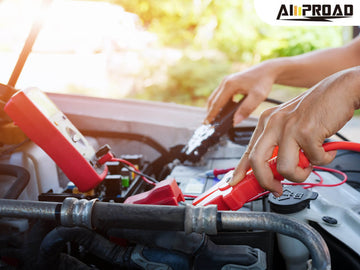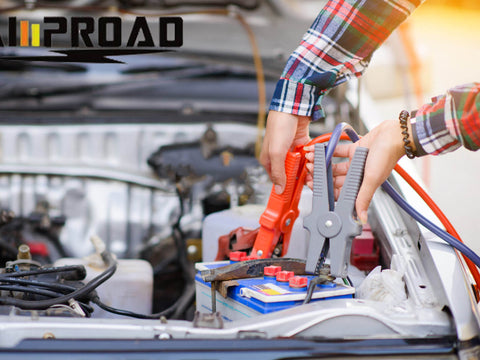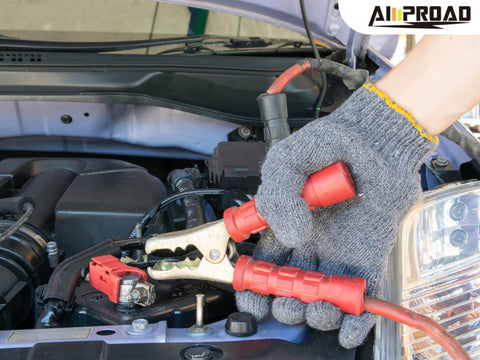
Jumper cables serve as essential tools for jump-starting vehicles with dead batteries. They facilitate the transfer of electrical power from a functional battery to the dead battery, allowing the vehicle to start. However, questions often arise regarding the effectiveness of leaving jumper cables connected for an extended period. But does leaving jumper cables connected for a longer time help the dead battery recover or recharge more effectively?
This question delves into the common misconception that leaving jumper cables connected for a longer duration will result in a more effective recharge of the dead battery. The belief stems from the idea that prolonged connection allows for a more thorough transfer of electrical energy to the dead battery, potentially aiding in its recovery.
In addressing this query, it's essential to explore the underlying mechanisms of battery charging and understand how jumper cables facilitate the process. By examining factors such as voltage, current flow, and battery chemistry, we can determine whether leaving jumper cables connected for an extended period indeed contributes to the effective recovery or recharge of a dead battery.
The Jump-Start Process and Its Limits
How to boost a car with jumper cables? Jump-starting a car with jumper cables is a straightforward process designed to provide a temporary electrical boost to a vehicle's dead battery. Understanding how jumper cables work and the steps involved in the jump-start process is essential for effectively reviving a dead battery.
How Do Jumper Cables Work?
Jumper cables serve as conduits for transferring electrical power from a functional vehicle's battery to the dead battery of another vehicle. They provide a temporary electrical connection between the two batteries, allowing the dead battery to receive the necessary voltage and current to start the engine.
Steps for Jump-Starting a Car with a Dead Battery
- Position the functional vehicle close enough to the vehicle with the dead battery to allow the jumper cables to reach both batteries.
- Ensure that both vehicles are turned off and that the parking brakes are engaged.
- Open the hoods of both vehicles and locate the batteries.
- Identify the positive (+) and negative (-) terminals on each battery.
- Connect one end of the red (positive) jumper cable to the positive terminal of the dead battery.
- Connect the other end of the red jumper cable to the positive terminal of the functional vehicle's battery.
- Connect one end of the black (negative) jumper cable to the negative terminal of the functional vehicle's battery.
- Connect the other end of the black jumper cable to a metal surface on the vehicle with the dead battery, away from the battery and fuel system.
- Start the engine of the functional vehicle and let it run for a few minutes to charge the dead battery.
- Attempt to start the engine of the vehicle with the dead battery. If successful, let it run for a few minutes to ensure the battery is sufficiently charged.
Disconnecting the Cables
- Once the vehicle with the dead battery is running smoothly, carefully disconnect the jumper cables in the reverse order they were connected.
- Start by removing the black (negative) jumper cable from the metal surface on the vehicle with the dead battery.
- Next, remove the black jumper cable from the negative terminal of the functional vehicle's battery.
- Remove the red (positive) jumper cable from the positive terminal of the functional vehicle's battery.
- Finally, remove the red jumper cable from the positive terminal of the dead battery.
Following these steps ensures a safe and effective jump-start process while minimizing the risk of electrical damage or injury.
Does Leaving Cables Help?

A common belief among many car owners is that leaving jumper cables connected for an extended period helps the dead battery charge more effectively. However, this notion is a misconception rooted in a misunderstanding of how jumper cables function.
Is It True that Leaving Jumper Cables Connected Helps the Dead Battery Charge More?
Contrary to popular belief, leaving jumper cables connected for a longer duration does not contribute to the effective charging of a dead battery. Jumper cables serve a specific purpose: to provide a temporary current flow from a functional battery to the dead battery in order to start the engine. They are not designed for long-term charging or replenishing the dead battery's charge.
Why or Why Not?
The primary function of jumper cables is to establish a temporary electrical connection between two batteries, allowing the dead battery to draw the necessary voltage and current to start the engine. Once the engine is running, the vehicle's alternator takes over, providing power to the electrical system and charging the battery.
Leaving jumper cables connected for an extended period does not contribute to the charging process because jumper cables do not provide a continuous flow of current to the dead battery. Instead, they facilitate a one-time transfer of electrical energy to initiate the engine start.
Attempting to use jumper cables as a substitute for a proper battery charger or charging system can potentially lead to overcharging or damage to the vehicle's electrical system. It's essential to use jumper cables only for their intended purpose – jump start a vehicle – and to rely on alternative methods, such as battery chargers, for long-term battery charging.
Thus, leaving jumper cables connected for an extended period does not help the dead battery charge more effectively. Jumper cables provide a temporary current flow to start the engine but are not designed for prolonged charging. It's important to understand the limitations of jumper cables and use them appropriately to avoid damage to the vehicle's electrical system.
Potential Risks of Leaving Cables Connected
While jumper cables are invaluable for jump-starting vehicles with dead batteries, leaving them connected for extended periods poses potential risks that should not be overlooked.
Potential Dangers of Extended Connection
One significant risk of leaving jumper cables connected for too long is the potential for overheating. The flow of electrical current through the cables generates heat, and prolonged exposure to this heat can cause the cables to become hot to the touch. In extreme cases, this heat can lead to damage to the insulation of the cables, increasing the risk of electrical shorts or fires.
Additionally, keeping jumper cables connected for an extended period can put strain on the electrical components of both vehicles involved. The constant flow of electrical current through the cables can overload the vehicle's electrical system, potentially causing damage to sensitive components such as the alternator, voltage regulator, or electronic control units.
Risk of Sparks
Another concern with leaving jumper cables connected for too long is the increased risk of sparks. Sparks can occur when connecting or disconnecting the jumper cables, especially if the cables are not securely attached or if there is corrosion on the battery terminals. These sparks can pose a fire hazard, particularly if they occur near flammable materials or gases present in the vicinity of the vehicle.
Precautions to Take
To mitigate the risks associated with leaving jumper cables connected for extended periods, it's essential to follow proper jump-starting procedures and disconnect the cables promptly once the vehicle with the dead battery is running. Additionally, ensure that the cables are securely attached to the battery terminals to minimize the risk of sparks. If you notice any signs of overheating or damage to the cables or electrical components, discontinue the jump-start process immediately and seek professional assistance.
Recommended Practices After Jump-Starting

After successfully jump-starting a vehicle, it's crucial to follow recommended practices to ensure the continued health of the battery and the safety of both vehicles involved.
Disconnecting the Jumper Cables
Properly disconnecting the jumper cables is an essential step to prevent potential electrical hazards and damage to the vehicles' electrical systems. To do so, start by turning off the engines of both vehicles. Then, carefully remove the jumper cables in the reverse order they were connected:
- Remove the black (negative) jumper cable from the metal surface on the vehicle with the dead battery.
- Next, remove the black jumper cable from the negative terminal of the functional vehicle's battery.
- Remove the red (positive) jumper cable from the positive terminal of the functional vehicle's battery.
- Finally, remove the red jumper cable from the positive terminal of the dead battery.
Following this sequence minimizes the risk of sparks and electrical shorts.
Duration of Running Time
After jump-starting, it's recommended to let the vehicle with the previously dead battery run for approximately 20 to 30 minutes. This running time allows the alternator to recharge the battery fully. During this period, the alternator supplies electrical power to the vehicle's electrical system while simultaneously replenishing the charge in the battery.
Importance of Running Time
Allowing the vehicle to run for the recommended duration is essential for the battery's health and longevity. The running time allows the battery to recharge fully, ensuring that it has sufficient power to start the engine reliably in subsequent uses. Additionally, fully recharging the battery helps prevent it from becoming depleted again prematurely.
Failure to run the vehicle for the recommended duration after jump-starting can result in an undercharged battery, which may lead to starting difficulties or premature battery failure in the future. Therefore, it's essential to adhere to the recommended running time to maintain the battery's health and ensure reliable vehicle operation.
Is jump starter better than jumper cable for boosting a dead car battery?
When comparing jump starters to jumper cables for boosting a dead car battery, each option offers distinct advantages.
Jump Starter Advantages:
Jump starters excel in convenience as they eliminate the need for another vehicle with a functional battery. With a jump starter, such as the AMPROAD portable jump starter, you can jump-start your car independently, making it ideal for situations where assistance is unavailable.
Safety is another key advantage of jump starters. Many models, including the AMPROAD portable jump starter, come equipped with built-in safety features such as spark protection and reverse polarity protection, mitigating the risk of damage to the vehicle or injury to the user during the jump-start process.
Additionally, jump starters are highly portable. Their compact and lightweight design, exemplified by the AMPROAD portable jump starter, allows for easy storage in your vehicle, ensuring that you have access to a reliable power source wherever you go.
Some jump starters offer versatility beyond jump-starting capabilities. They can double as portable power banks, enabling you to charge phones or other devices on the go, adding an extra layer of functionality.
Jumper Cable Advantages:
While jump starters offer numerous benefits, jumper cables have their advantages as well. Cost-effectiveness is a significant factor, as jumper cables are generally much more affordable than jump starters, making them a budget-friendly option for many drivers.
Jumper cables are also simpler to use, requiring no additional equipment beyond the cables themselves. The straightforward process of connecting the cables to the batteries of both vehicles makes them accessible to drivers of all skill levels.
While jump starters offer convenience, safety, and portability, jumper cables remain a cost-effective and straightforward solution for jump-starting a dead car battery. The choice between the two ultimately depends on individual preferences and needs.
FAQs / People also Ask
Q: Will leaving jumper cables connected for a longer duration help the dead battery charge more effectively?
A: No, leaving jumper cables connected for an extended period does not contribute to the effective charging of a dead battery. Jumper cables provide a temporary current flow to start the engine but are not designed for prolonged charging.
Q: Why is there a misconception that longer connection times aid in charging the dead battery?
A: The misconception stems from a misunderstanding of how jumper cables function. Some believe that longer connection times allow for a more thorough transfer of electrical energy to the dead battery, but in reality, jumper cables are meant for jump-starting, not for long-term charging.
Q: What are the potential risks of leaving jumper cables connected for extended periods?
A: There are several potential risks, including overheating of the cables, damage to electrical components in the vehicles, and an increased risk of sparks. Overheating can lead to damage to the cables' insulation, while prolonged current flow can strain the vehicles' electrical systems.


